Coursework 1: Analysis of Authentic and Ethical Leadership Models
VerifiedAdded on 2023/01/11
|11
|3131
|47
Report
AI Summary
This report provides a comprehensive analysis of two prominent leadership models: authentic and ethical leadership. It begins by defining both models and exploring their core principles, emphasizing the importance of leadership in driving organizational change and motivating individuals. The report delves into the strengths and weaknesses of each model, using real-world examples from organizations like Tesco and ASDA to illustrate key concepts. The analysis includes discussions on self-awareness, emotional intelligence, long-term focus, and ethical considerations. The report concludes by evaluating both models in the context of current market conditions, ultimately proposing the most suitable leadership style for today's challenges, with supporting arguments and rationale. The report also considers the implications of leadership styles on organizational culture, employee engagement, and overall business performance, providing a well-rounded perspective on effective leadership.
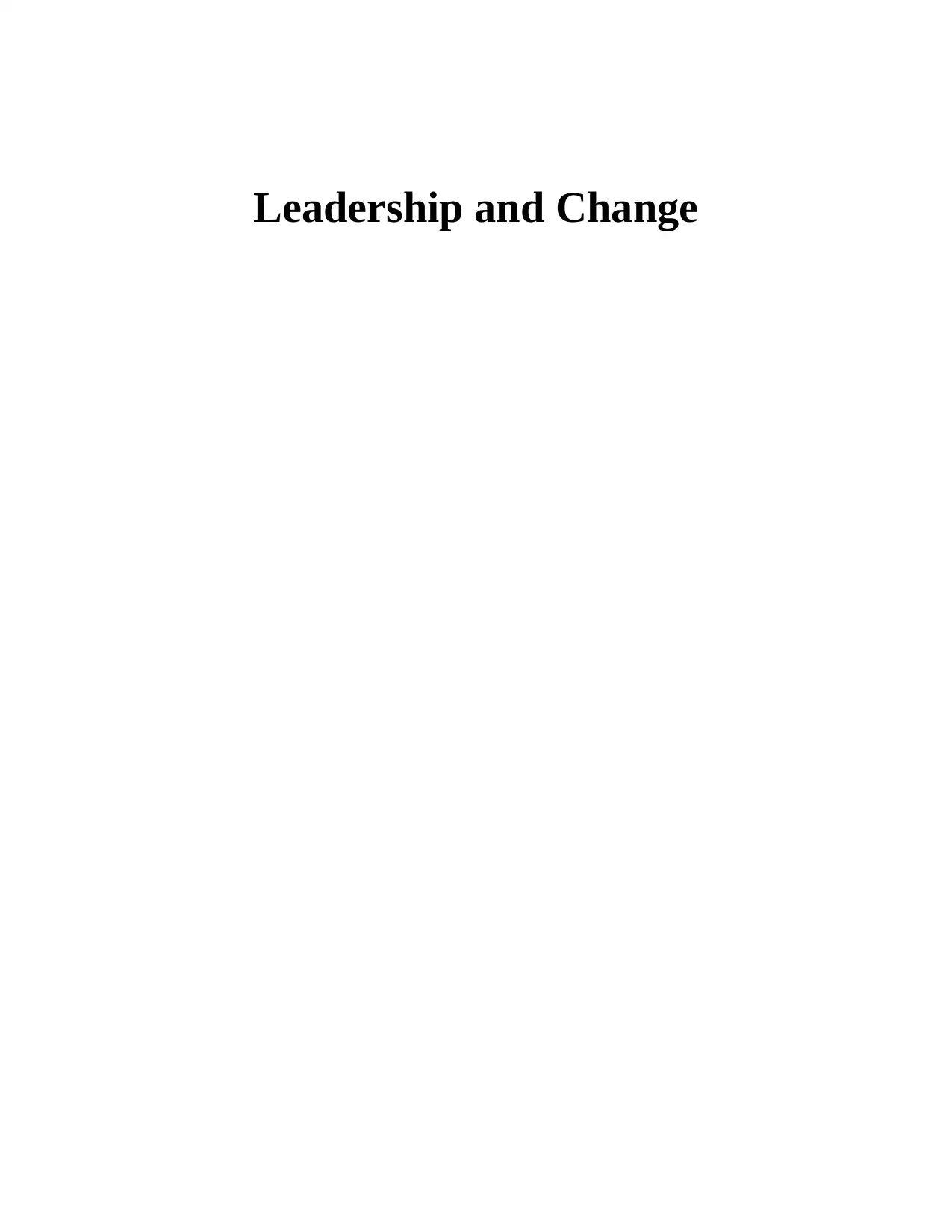
Leadership and Change
Paraphrase This Document
Need a fresh take? Get an instant paraphrase of this document with our AI Paraphraser
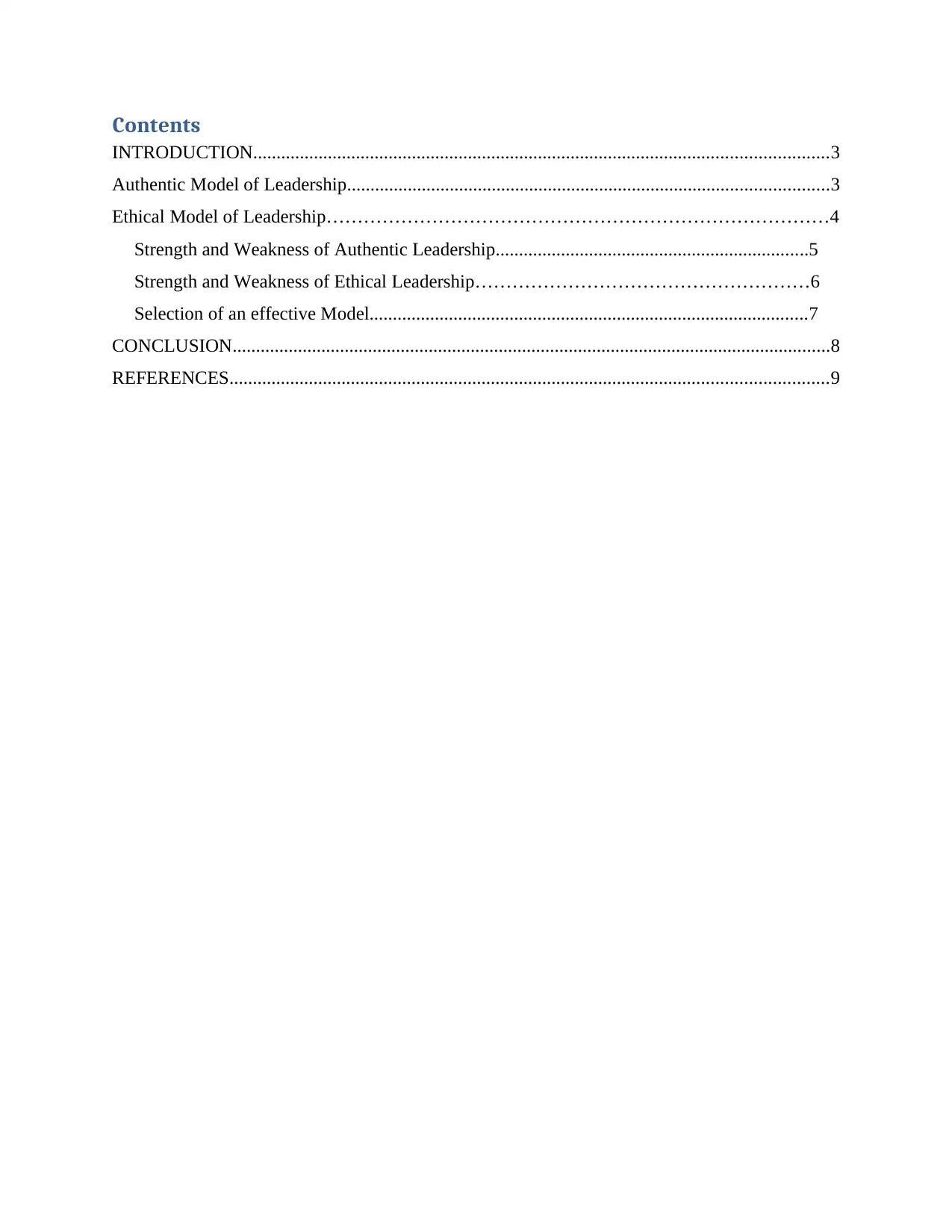
Contents
INTRODUCTION...........................................................................................................................3
Authentic Model of Leadership.......................................................................................................3
Ethical Model of Leadership………………………………………………………………………4
Strength and Weakness of Authentic Leadership...................................................................5
Strength and Weakness of Ethical Leadership………………………………………………6
Selection of an effective Model..............................................................................................7
CONCLUSION................................................................................................................................8
REFERENCES................................................................................................................................9
INTRODUCTION...........................................................................................................................3
Authentic Model of Leadership.......................................................................................................3
Ethical Model of Leadership………………………………………………………………………4
Strength and Weakness of Authentic Leadership...................................................................5
Strength and Weakness of Ethical Leadership………………………………………………6
Selection of an effective Model..............................................................................................7
CONCLUSION................................................................................................................................8
REFERENCES................................................................................................................................9

INTRODUCTION
Leadership and change explained as two important aspect of an organisation that provides
ability to influence and enthuse other individuals through utilising personal advocacy, drive and
vision for implementing change in organisation. Leadership is recognised as an important aspect
that motivates individuals to adopts alternations in organisational premises (Burnes et al, 2018).
The report highlights on authentic leadership and ethical leadership that are well-known models
of leadership. Defining leadership is difficult as leadership is not the same for individuals, there
are so many different paths to efficient leadership. This report reflects on authentic leadership
and many more styles from the viewpoints of Tesco and many other organisations that are
performing operations at global levels (van Dierendonck and Sousa, 2016). Finally, we consider
which would be a suitable style for organisation according to present market conditions.
Authentic Model of Leadership
According to the Moo Jun Hao (2015) leadership is defined as the most important aspect
that is leading organisations to generate and implement effective change among all organisations
through generating motivation within an individual or engaged workforce in business. The main
motive of effective leadership is to generate better outcomes from organisational operations
through implementing innovation in the organisation. Effective leadership is a crucial aspect that
leads management to control and facilitate better vision, mission and culture among
organisations that generates positive relations between leader and employee through working on
same vision.
The term authentic leadership is defined as an approach which emphasizes on individuals for
building better leader’s legitimacy through developing positive and honest relationship with its
followers. Moreover, leadership is providing better input, developing ethical foundation and in
the context of authentic leaders, refers to positive individuals that work with self-concepts and
promote openness in the organisation (Heathfield, 2019).
Authentic leadership is defined as a growing area of study which is related with academic
research and it is increasing from beginnings to a total grown concept. This governs that
according to present market conditions leadership style is required among all field. So leader
must adopt change in minimum time period as leadership is an universal approach.
Leadership and change explained as two important aspect of an organisation that provides
ability to influence and enthuse other individuals through utilising personal advocacy, drive and
vision for implementing change in organisation. Leadership is recognised as an important aspect
that motivates individuals to adopts alternations in organisational premises (Burnes et al, 2018).
The report highlights on authentic leadership and ethical leadership that are well-known models
of leadership. Defining leadership is difficult as leadership is not the same for individuals, there
are so many different paths to efficient leadership. This report reflects on authentic leadership
and many more styles from the viewpoints of Tesco and many other organisations that are
performing operations at global levels (van Dierendonck and Sousa, 2016). Finally, we consider
which would be a suitable style for organisation according to present market conditions.
Authentic Model of Leadership
According to the Moo Jun Hao (2015) leadership is defined as the most important aspect
that is leading organisations to generate and implement effective change among all organisations
through generating motivation within an individual or engaged workforce in business. The main
motive of effective leadership is to generate better outcomes from organisational operations
through implementing innovation in the organisation. Effective leadership is a crucial aspect that
leads management to control and facilitate better vision, mission and culture among
organisations that generates positive relations between leader and employee through working on
same vision.
The term authentic leadership is defined as an approach which emphasizes on individuals for
building better leader’s legitimacy through developing positive and honest relationship with its
followers. Moreover, leadership is providing better input, developing ethical foundation and in
the context of authentic leaders, refers to positive individuals that work with self-concepts and
promote openness in the organisation (Heathfield, 2019).
Authentic leadership is defined as a growing area of study which is related with academic
research and it is increasing from beginnings to a total grown concept. This governs that
according to present market conditions leadership style is required among all field. So leader
must adopt change in minimum time period as leadership is an universal approach.
⊘ This is a preview!⊘
Do you want full access?
Subscribe today to unlock all pages.

Trusted by 1+ million students worldwide

With the recent year’s analysis from SME and large organisation (https://www.ethnicity-facts-
figures.service.gov.uk/workforce-and-business/business/leadership-of-small-and-medium
enterprise/latest) it is identified that authentic leadership is a wide term which is a modern and
more inclusive approach towards leadership.
Some important aspects that are included in the authentic style of leadership are mention as
below:
Self-awareness- An authentic leader reflects upon all action, decisions and activities
that help to understand strength and weakness without any biasness. Organisation put
large efforts for overcome fears and use maximum aspect to enhance strength. Leaders
use awareness to improve their own performance and relationships with others, making
them a leader that others are willing to follow (Blekkingh, 2015).
Lead with emotion- Authentic leaders is all about heart and they are not afraid to
implement deep changes in organisation (Men and Stacks, 2014). This aids an authentic
leader to enhance courage and empathy within their behaviour that only comes when a
leader follows their heart that impact on followers to monitor them as an ideal.
Example- Leaders not distress from change so the followers also adopt required
changes (Price, 2017).
Focus on long term result- Authentic leaders do not waste time unnecessarily such as
non-achievement due to setbacks achievement. It is accomplish by motivating all
workforce to engage in adoption for changes among organisation (Burnes, 2018) It
refers that management is focusing to set and achieve long term results. Sainsbury’s
leaders implement their hard work on regular basis..
Lead with vision- Authentic leaders perform their role for achieving a purpose or
vision, it is also used by management for adding better value that helps to interact with
individuals in an appropriate manner (Ladkin, 2020). Tesco leaders use this as a
modern approach that is used for making better results or work standards of an
individual to implement in decided time period (Schell, 2019).
figures.service.gov.uk/workforce-and-business/business/leadership-of-small-and-medium
enterprise/latest) it is identified that authentic leadership is a wide term which is a modern and
more inclusive approach towards leadership.
Some important aspects that are included in the authentic style of leadership are mention as
below:
Self-awareness- An authentic leader reflects upon all action, decisions and activities
that help to understand strength and weakness without any biasness. Organisation put
large efforts for overcome fears and use maximum aspect to enhance strength. Leaders
use awareness to improve their own performance and relationships with others, making
them a leader that others are willing to follow (Blekkingh, 2015).
Lead with emotion- Authentic leaders is all about heart and they are not afraid to
implement deep changes in organisation (Men and Stacks, 2014). This aids an authentic
leader to enhance courage and empathy within their behaviour that only comes when a
leader follows their heart that impact on followers to monitor them as an ideal.
Example- Leaders not distress from change so the followers also adopt required
changes (Price, 2017).
Focus on long term result- Authentic leaders do not waste time unnecessarily such as
non-achievement due to setbacks achievement. It is accomplish by motivating all
workforce to engage in adoption for changes among organisation (Burnes, 2018) It
refers that management is focusing to set and achieve long term results. Sainsbury’s
leaders implement their hard work on regular basis..
Lead with vision- Authentic leaders perform their role for achieving a purpose or
vision, it is also used by management for adding better value that helps to interact with
individuals in an appropriate manner (Ladkin, 2020). Tesco leaders use this as a
modern approach that is used for making better results or work standards of an
individual to implement in decided time period (Schell, 2019).
Paraphrase This Document
Need a fresh take? Get an instant paraphrase of this document with our AI Paraphraser
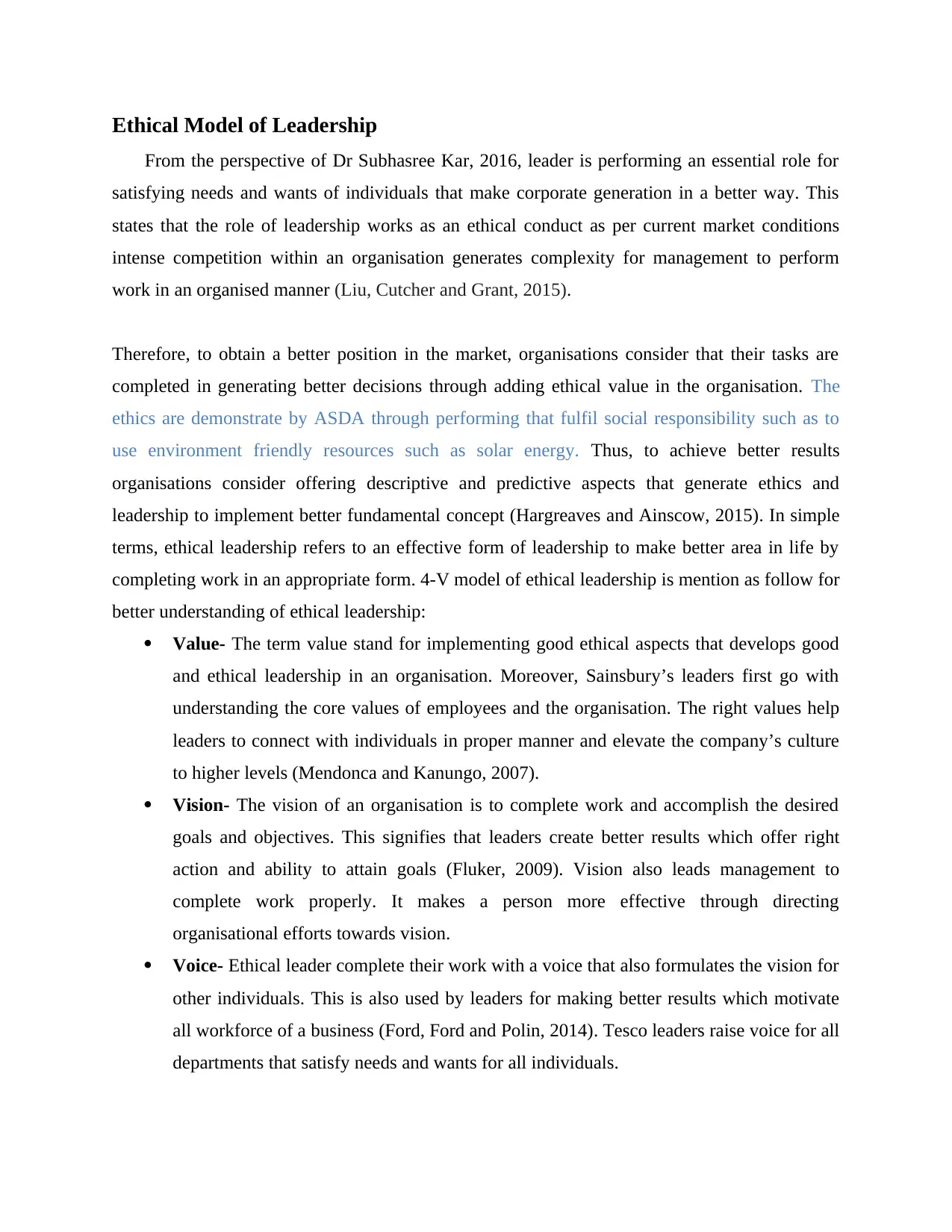
Ethical Model of Leadership
From the perspective of Dr Subhasree Kar, 2016, leader is performing an essential role for
satisfying needs and wants of individuals that make corporate generation in a better way. This
states that the role of leadership works as an ethical conduct as per current market conditions
intense competition within an organisation generates complexity for management to perform
work in an organised manner (Liu, Cutcher and Grant, 2015).
Therefore, to obtain a better position in the market, organisations consider that their tasks are
completed in generating better decisions through adding ethical value in the organisation. The
ethics are demonstrate by ASDA through performing that fulfil social responsibility such as to
use environment friendly resources such as solar energy. Thus, to achieve better results
organisations consider offering descriptive and predictive aspects that generate ethics and
leadership to implement better fundamental concept (Hargreaves and Ainscow, 2015). In simple
terms, ethical leadership refers to an effective form of leadership to make better area in life by
completing work in an appropriate form. 4-V model of ethical leadership is mention as follow for
better understanding of ethical leadership:
Value- The term value stand for implementing good ethical aspects that develops good
and ethical leadership in an organisation. Moreover, Sainsbury’s leaders first go with
understanding the core values of employees and the organisation. The right values help
leaders to connect with individuals in proper manner and elevate the company’s culture
to higher levels (Mendonca and Kanungo, 2007).
Vision- The vision of an organisation is to complete work and accomplish the desired
goals and objectives. This signifies that leaders create better results which offer right
action and ability to attain goals (Fluker, 2009). Vision also leads management to
complete work properly. It makes a person more effective through directing
organisational efforts towards vision.
Voice- Ethical leader complete their work with a voice that also formulates the vision for
other individuals. This is also used by leaders for making better results which motivate
all workforce of a business (Ford, Ford and Polin, 2014). Tesco leaders raise voice for all
departments that satisfy needs and wants for all individuals.
From the perspective of Dr Subhasree Kar, 2016, leader is performing an essential role for
satisfying needs and wants of individuals that make corporate generation in a better way. This
states that the role of leadership works as an ethical conduct as per current market conditions
intense competition within an organisation generates complexity for management to perform
work in an organised manner (Liu, Cutcher and Grant, 2015).
Therefore, to obtain a better position in the market, organisations consider that their tasks are
completed in generating better decisions through adding ethical value in the organisation. The
ethics are demonstrate by ASDA through performing that fulfil social responsibility such as to
use environment friendly resources such as solar energy. Thus, to achieve better results
organisations consider offering descriptive and predictive aspects that generate ethics and
leadership to implement better fundamental concept (Hargreaves and Ainscow, 2015). In simple
terms, ethical leadership refers to an effective form of leadership to make better area in life by
completing work in an appropriate form. 4-V model of ethical leadership is mention as follow for
better understanding of ethical leadership:
Value- The term value stand for implementing good ethical aspects that develops good
and ethical leadership in an organisation. Moreover, Sainsbury’s leaders first go with
understanding the core values of employees and the organisation. The right values help
leaders to connect with individuals in proper manner and elevate the company’s culture
to higher levels (Mendonca and Kanungo, 2007).
Vision- The vision of an organisation is to complete work and accomplish the desired
goals and objectives. This signifies that leaders create better results which offer right
action and ability to attain goals (Fluker, 2009). Vision also leads management to
complete work properly. It makes a person more effective through directing
organisational efforts towards vision.
Voice- Ethical leader complete their work with a voice that also formulates the vision for
other individuals. This is also used by leaders for making better results which motivate
all workforce of a business (Ford, Ford and Polin, 2014). Tesco leaders raise voice for all
departments that satisfy needs and wants for all individuals.

Virtue- Ethical leaders work as the role model for an individual that makes better
behaviour and leads companies to act appropriately in the organisation. Aldi is
implementing all these models for obtaining more products and services.
The 4-V of ethical leadership supports the alignment of internal principles and values with
external actions and conducts for the objective and goals. By exhibiting ethical leadership, we
uphold integrity which inspires a perception of trustworthiness, and urges employees to accept
and follow your vision. Ethical Leadership Model is considered effective in generating better
leadership in a respective organisation (Bormann, Rowold and Hoffjan, 2014).
Strength and Weakness of Authentic leadership
There are various leadership models that work with the perspective of generating better strength
within an organisation. From the point view of Dimitriou (2014) it is mandatory for leaders to
complete work in a proper manner, to adopt a leadership style that makes better results.
Strength
Authentic model of leadership allows leaders to set goals that ensures management to
complete all work to high quality. It allows leaders to perform all operations and
functions by generating inspiration among other staff members. Example- The Authentic
leader of Tesco gain right results by focusing on strength of workforce through
technology and utilise tools and utilise them in current operations of organisation.
(Snyder and Stackpole, 2014)
Enables leaders to gain more experience resulting in better authenticity among leaders by
using experience from their previous learning. Tasks are performed by management to
generate consistency which leads to establish common ground in the organisation through
developing a defensive environment (Engelbrecht, Heine and Mahembe, 2017). Example-
Tesco leader enter in global market with using laissez-faire leadership style it help to
understand environment and then to implement right policy.
Weakness
Authentic leadership requires transparency and honesty between leaders and followers,
however sometimes true authenticity and transparency can result in followers losing trust
behaviour and leads companies to act appropriately in the organisation. Aldi is
implementing all these models for obtaining more products and services.
The 4-V of ethical leadership supports the alignment of internal principles and values with
external actions and conducts for the objective and goals. By exhibiting ethical leadership, we
uphold integrity which inspires a perception of trustworthiness, and urges employees to accept
and follow your vision. Ethical Leadership Model is considered effective in generating better
leadership in a respective organisation (Bormann, Rowold and Hoffjan, 2014).
Strength and Weakness of Authentic leadership
There are various leadership models that work with the perspective of generating better strength
within an organisation. From the point view of Dimitriou (2014) it is mandatory for leaders to
complete work in a proper manner, to adopt a leadership style that makes better results.
Strength
Authentic model of leadership allows leaders to set goals that ensures management to
complete all work to high quality. It allows leaders to perform all operations and
functions by generating inspiration among other staff members. Example- The Authentic
leader of Tesco gain right results by focusing on strength of workforce through
technology and utilise tools and utilise them in current operations of organisation.
(Snyder and Stackpole, 2014)
Enables leaders to gain more experience resulting in better authenticity among leaders by
using experience from their previous learning. Tasks are performed by management to
generate consistency which leads to establish common ground in the organisation through
developing a defensive environment (Engelbrecht, Heine and Mahembe, 2017). Example-
Tesco leader enter in global market with using laissez-faire leadership style it help to
understand environment and then to implement right policy.
Weakness
Authentic leadership requires transparency and honesty between leaders and followers,
however sometimes true authenticity and transparency can result in followers losing trust
⊘ This is a preview!⊘
Do you want full access?
Subscribe today to unlock all pages.

Trusted by 1+ million students worldwide
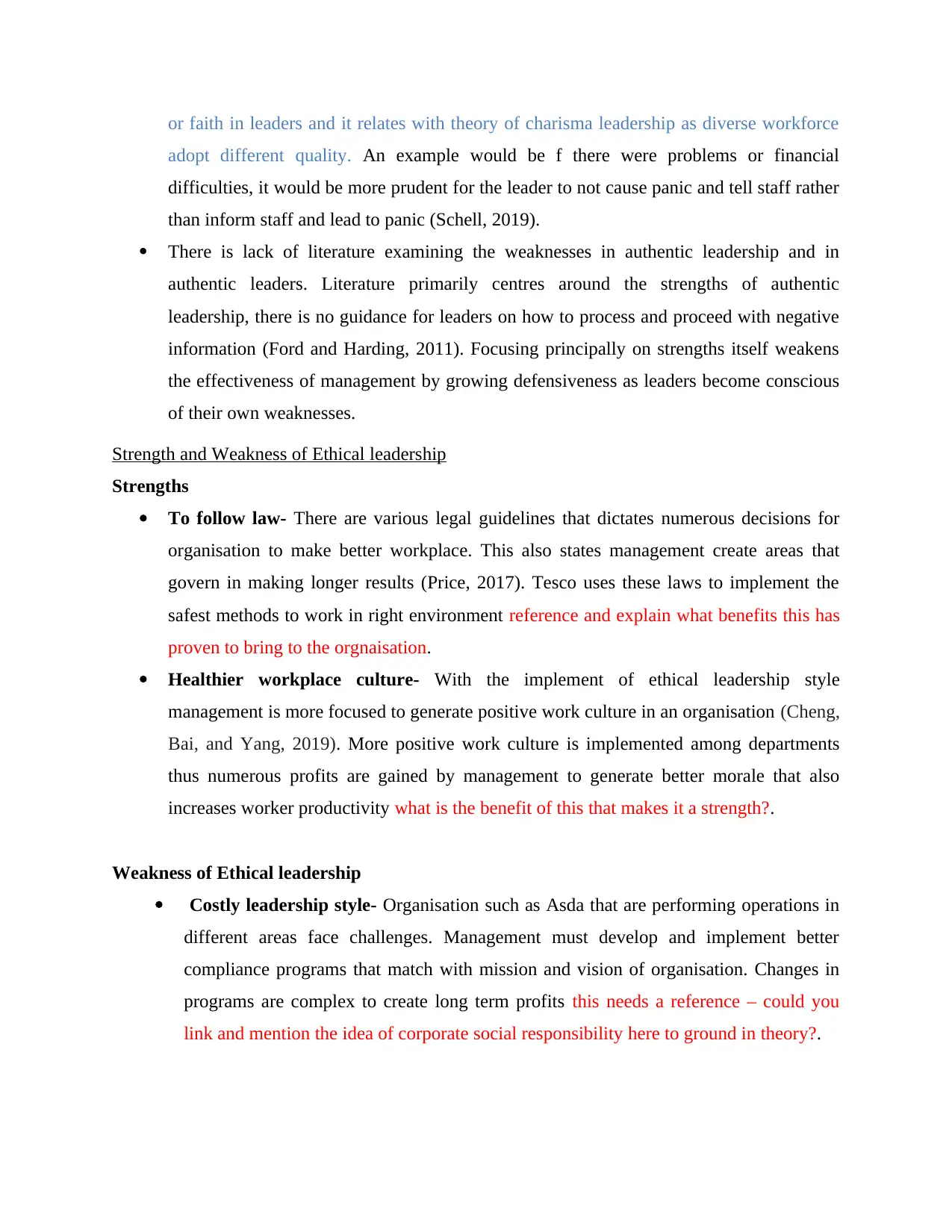
or faith in leaders and it relates with theory of charisma leadership as diverse workforce
adopt different quality. An example would be f there were problems or financial
difficulties, it would be more prudent for the leader to not cause panic and tell staff rather
than inform staff and lead to panic (Schell, 2019).
There is lack of literature examining the weaknesses in authentic leadership and in
authentic leaders. Literature primarily centres around the strengths of authentic
leadership, there is no guidance for leaders on how to process and proceed with negative
information (Ford and Harding, 2011). Focusing principally on strengths itself weakens
the effectiveness of management by growing defensiveness as leaders become conscious
of their own weaknesses.
Strength and Weakness of Ethical leadership
Strengths
To follow law- There are various legal guidelines that dictates numerous decisions for
organisation to make better workplace. This also states management create areas that
govern in making longer results (Price, 2017). Tesco uses these laws to implement the
safest methods to work in right environment reference and explain what benefits this has
proven to bring to the orgnaisation.
Healthier workplace culture- With the implement of ethical leadership style
management is more focused to generate positive work culture in an organisation (Cheng,
Bai, and Yang, 2019). More positive work culture is implemented among departments
thus numerous profits are gained by management to generate better morale that also
increases worker productivity what is the benefit of this that makes it a strength?.
Weakness of Ethical leadership
Costly leadership style- Organisation such as Asda that are performing operations in
different areas face challenges. Management must develop and implement better
compliance programs that match with mission and vision of organisation. Changes in
programs are complex to create long term profits this needs a reference – could you
link and mention the idea of corporate social responsibility here to ground in theory?.
adopt different quality. An example would be f there were problems or financial
difficulties, it would be more prudent for the leader to not cause panic and tell staff rather
than inform staff and lead to panic (Schell, 2019).
There is lack of literature examining the weaknesses in authentic leadership and in
authentic leaders. Literature primarily centres around the strengths of authentic
leadership, there is no guidance for leaders on how to process and proceed with negative
information (Ford and Harding, 2011). Focusing principally on strengths itself weakens
the effectiveness of management by growing defensiveness as leaders become conscious
of their own weaknesses.
Strength and Weakness of Ethical leadership
Strengths
To follow law- There are various legal guidelines that dictates numerous decisions for
organisation to make better workplace. This also states management create areas that
govern in making longer results (Price, 2017). Tesco uses these laws to implement the
safest methods to work in right environment reference and explain what benefits this has
proven to bring to the orgnaisation.
Healthier workplace culture- With the implement of ethical leadership style
management is more focused to generate positive work culture in an organisation (Cheng,
Bai, and Yang, 2019). More positive work culture is implemented among departments
thus numerous profits are gained by management to generate better morale that also
increases worker productivity what is the benefit of this that makes it a strength?.
Weakness of Ethical leadership
Costly leadership style- Organisation such as Asda that are performing operations in
different areas face challenges. Management must develop and implement better
compliance programs that match with mission and vision of organisation. Changes in
programs are complex to create long term profits this needs a reference – could you
link and mention the idea of corporate social responsibility here to ground in theory?.
Paraphrase This Document
Need a fresh take? Get an instant paraphrase of this document with our AI Paraphraser
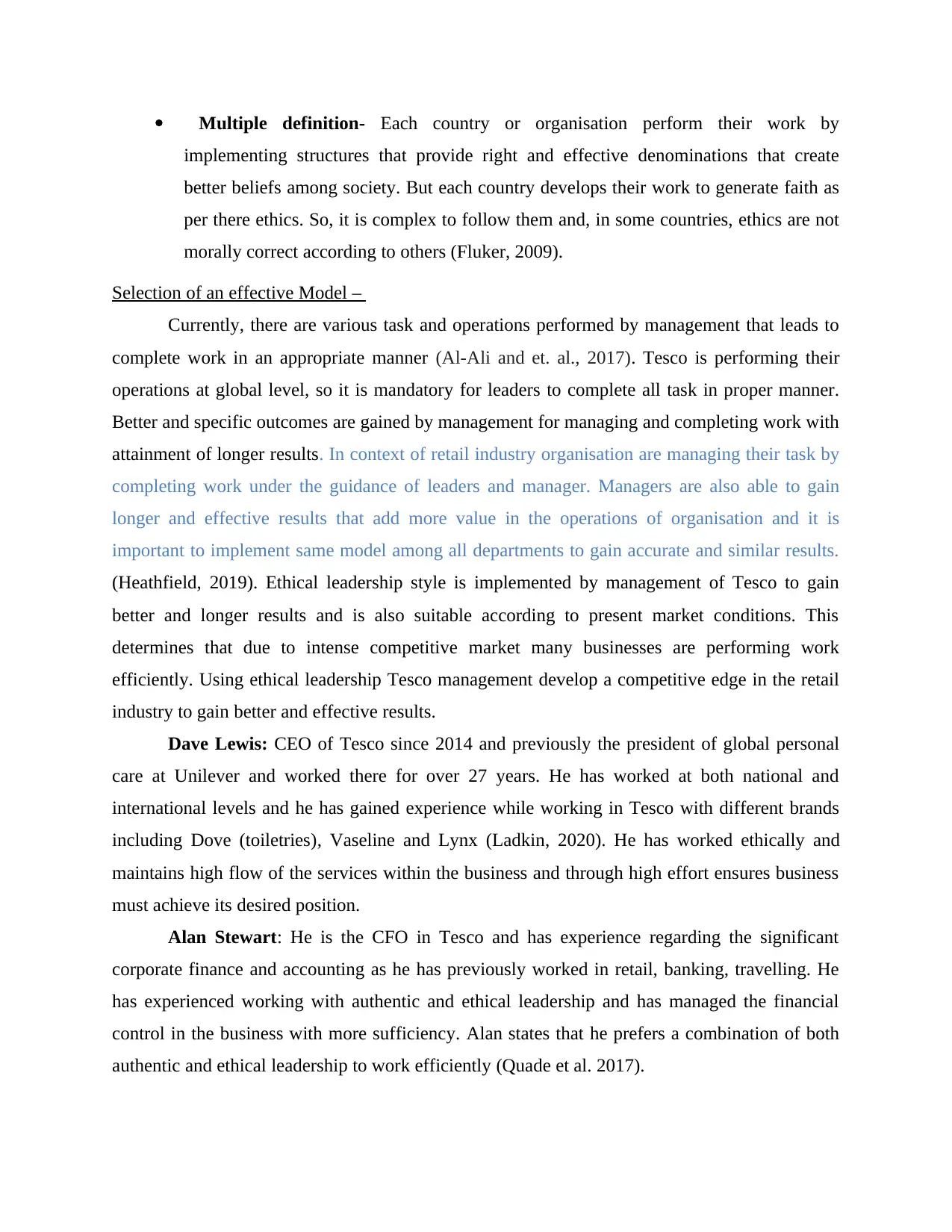
Multiple definition- Each country or organisation perform their work by
implementing structures that provide right and effective denominations that create
better beliefs among society. But each country develops their work to generate faith as
per there ethics. So, it is complex to follow them and, in some countries, ethics are not
morally correct according to others (Fluker, 2009).
Selection of an effective Model –
Currently, there are various task and operations performed by management that leads to
complete work in an appropriate manner (Al-Ali and et. al., 2017). Tesco is performing their
operations at global level, so it is mandatory for leaders to complete all task in proper manner.
Better and specific outcomes are gained by management for managing and completing work with
attainment of longer results. In context of retail industry organisation are managing their task by
completing work under the guidance of leaders and manager. Managers are also able to gain
longer and effective results that add more value in the operations of organisation and it is
important to implement same model among all departments to gain accurate and similar results.
(Heathfield, 2019). Ethical leadership style is implemented by management of Tesco to gain
better and longer results and is also suitable according to present market conditions. This
determines that due to intense competitive market many businesses are performing work
efficiently. Using ethical leadership Tesco management develop a competitive edge in the retail
industry to gain better and effective results.
Dave Lewis: CEO of Tesco since 2014 and previously the president of global personal
care at Unilever and worked there for over 27 years. He has worked at both national and
international levels and he has gained experience while working in Tesco with different brands
including Dove (toiletries), Vaseline and Lynx (Ladkin, 2020). He has worked ethically and
maintains high flow of the services within the business and through high effort ensures business
must achieve its desired position.
Alan Stewart: He is the CFO in Tesco and has experience regarding the significant
corporate finance and accounting as he has previously worked in retail, banking, travelling. He
has experienced working with authentic and ethical leadership and has managed the financial
control in the business with more sufficiency. Alan states that he prefers a combination of both
authentic and ethical leadership to work efficiently (Quade et al. 2017).
implementing structures that provide right and effective denominations that create
better beliefs among society. But each country develops their work to generate faith as
per there ethics. So, it is complex to follow them and, in some countries, ethics are not
morally correct according to others (Fluker, 2009).
Selection of an effective Model –
Currently, there are various task and operations performed by management that leads to
complete work in an appropriate manner (Al-Ali and et. al., 2017). Tesco is performing their
operations at global level, so it is mandatory for leaders to complete all task in proper manner.
Better and specific outcomes are gained by management for managing and completing work with
attainment of longer results. In context of retail industry organisation are managing their task by
completing work under the guidance of leaders and manager. Managers are also able to gain
longer and effective results that add more value in the operations of organisation and it is
important to implement same model among all departments to gain accurate and similar results.
(Heathfield, 2019). Ethical leadership style is implemented by management of Tesco to gain
better and longer results and is also suitable according to present market conditions. This
determines that due to intense competitive market many businesses are performing work
efficiently. Using ethical leadership Tesco management develop a competitive edge in the retail
industry to gain better and effective results.
Dave Lewis: CEO of Tesco since 2014 and previously the president of global personal
care at Unilever and worked there for over 27 years. He has worked at both national and
international levels and he has gained experience while working in Tesco with different brands
including Dove (toiletries), Vaseline and Lynx (Ladkin, 2020). He has worked ethically and
maintains high flow of the services within the business and through high effort ensures business
must achieve its desired position.
Alan Stewart: He is the CFO in Tesco and has experience regarding the significant
corporate finance and accounting as he has previously worked in retail, banking, travelling. He
has experienced working with authentic and ethical leadership and has managed the financial
control in the business with more sufficiency. Alan states that he prefers a combination of both
authentic and ethical leadership to work efficiently (Quade et al. 2017).
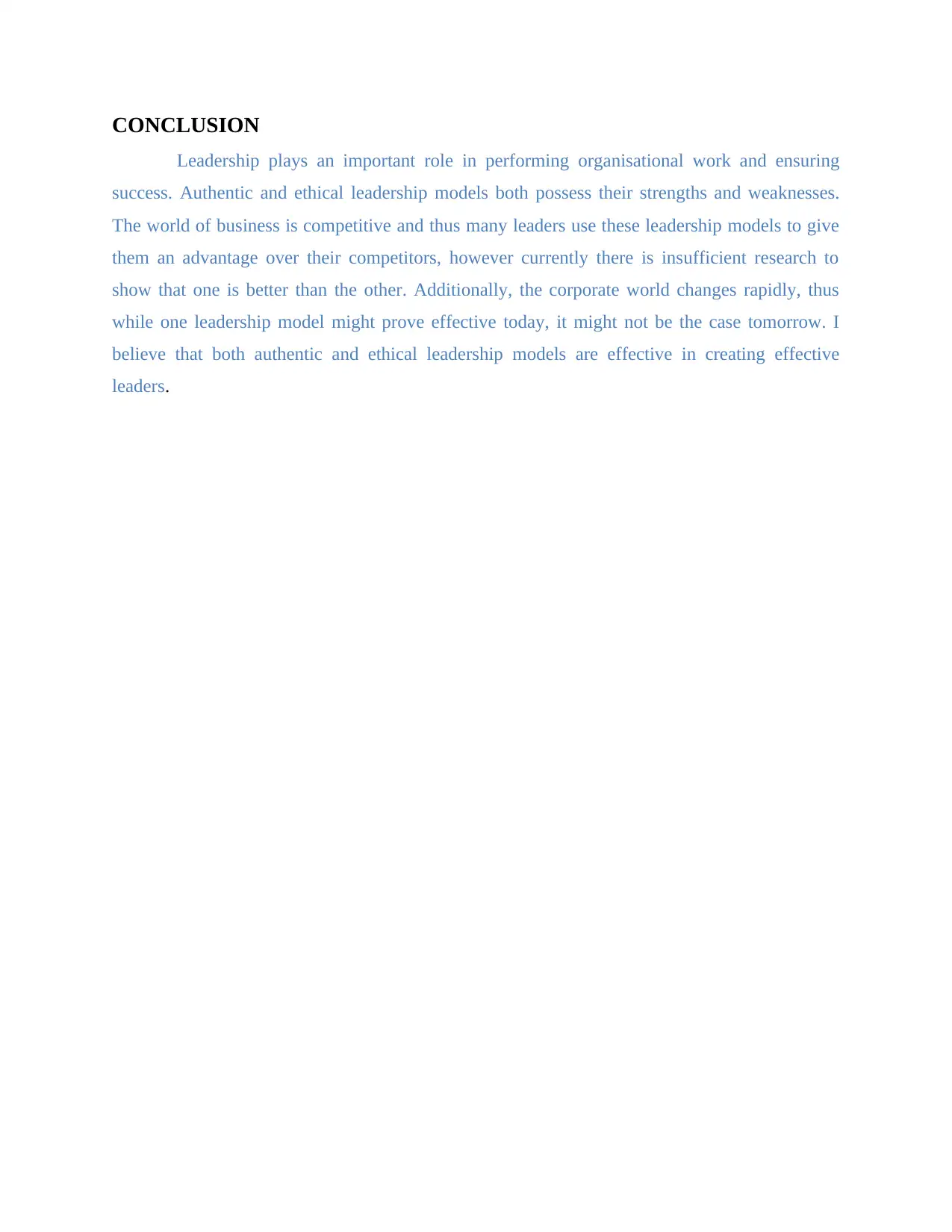
CONCLUSION
Leadership plays an important role in performing organisational work and ensuring
success. Authentic and ethical leadership models both possess their strengths and weaknesses.
The world of business is competitive and thus many leaders use these leadership models to give
them an advantage over their competitors, however currently there is insufficient research to
show that one is better than the other. Additionally, the corporate world changes rapidly, thus
while one leadership model might prove effective today, it might not be the case tomorrow. I
believe that both authentic and ethical leadership models are effective in creating effective
leaders.
Leadership plays an important role in performing organisational work and ensuring
success. Authentic and ethical leadership models both possess their strengths and weaknesses.
The world of business is competitive and thus many leaders use these leadership models to give
them an advantage over their competitors, however currently there is insufficient research to
show that one is better than the other. Additionally, the corporate world changes rapidly, thus
while one leadership model might prove effective today, it might not be the case tomorrow. I
believe that both authentic and ethical leadership models are effective in creating effective
leaders.
⊘ This is a preview!⊘
Do you want full access?
Subscribe today to unlock all pages.

Trusted by 1+ million students worldwide
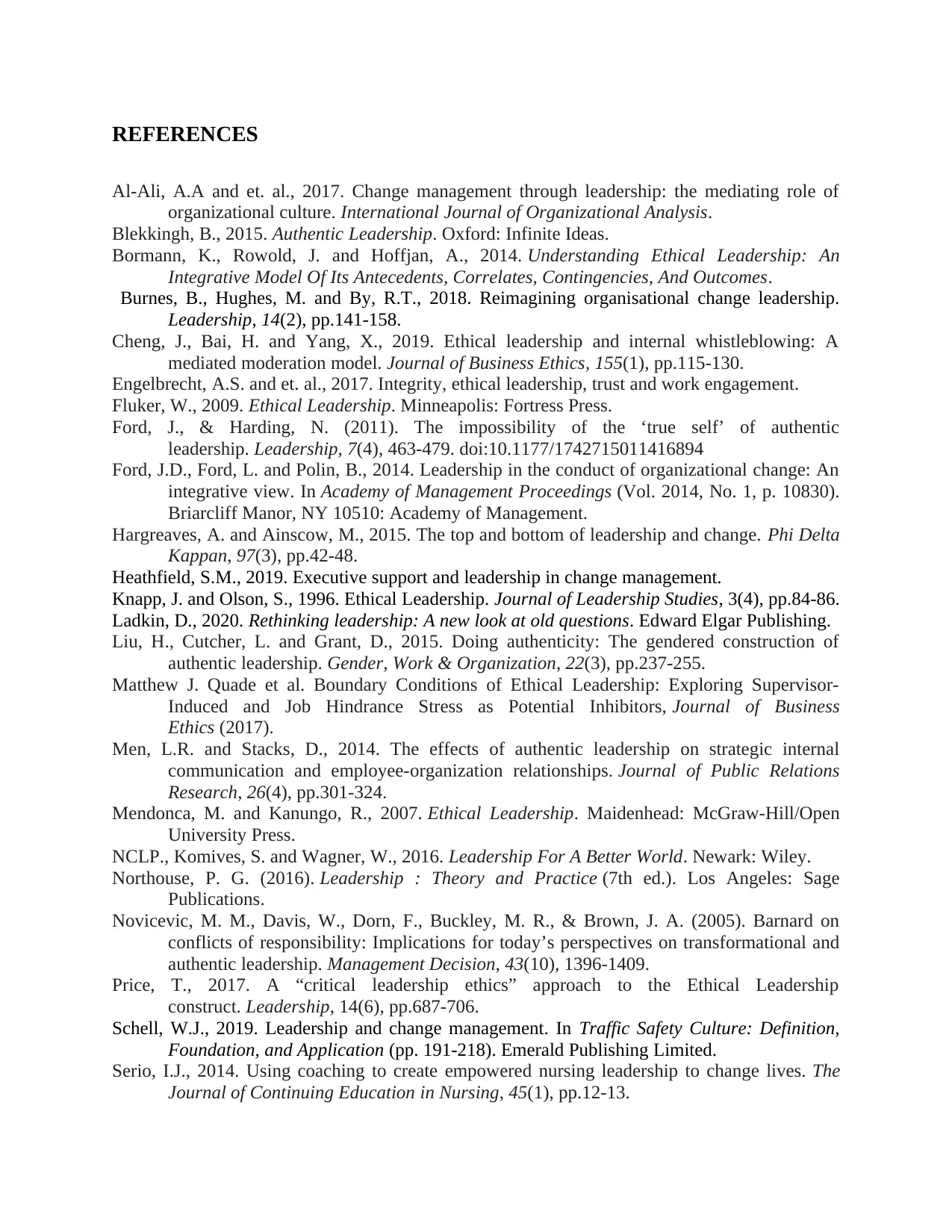
REFERENCES
Al-Ali, A.A and et. al., 2017. Change management through leadership: the mediating role of
organizational culture. International Journal of Organizational Analysis.
Blekkingh, B., 2015. Authentic Leadership. Oxford: Infinite Ideas.
Bormann, K., Rowold, J. and Hoffjan, A., 2014. Understanding Ethical Leadership: An
Integrative Model Of Its Antecedents, Correlates, Contingencies, And Outcomes.
Burnes, B., Hughes, M. and By, R.T., 2018. Reimagining organisational change leadership.
Leadership, 14(2), pp.141-158.
Cheng, J., Bai, H. and Yang, X., 2019. Ethical leadership and internal whistleblowing: A
mediated moderation model. Journal of Business Ethics, 155(1), pp.115-130.
Engelbrecht, A.S. and et. al., 2017. Integrity, ethical leadership, trust and work engagement.
Fluker, W., 2009. Ethical Leadership. Minneapolis: Fortress Press.
Ford, J., & Harding, N. (2011). The impossibility of the ‘true self’ of authentic
leadership. Leadership, 7(4), 463-479. doi:10.1177/1742715011416894
Ford, J.D., Ford, L. and Polin, B., 2014. Leadership in the conduct of organizational change: An
integrative view. In Academy of Management Proceedings (Vol. 2014, No. 1, p. 10830).
Briarcliff Manor, NY 10510: Academy of Management.
Hargreaves, A. and Ainscow, M., 2015. The top and bottom of leadership and change. Phi Delta
Kappan, 97(3), pp.42-48.
Heathfield, S.M., 2019. Executive support and leadership in change management.
Knapp, J. and Olson, S., 1996. Ethical Leadership. Journal of Leadership Studies, 3(4), pp.84-86.
Ladkin, D., 2020. Rethinking leadership: A new look at old questions. Edward Elgar Publishing.
Liu, H., Cutcher, L. and Grant, D., 2015. Doing authenticity: The gendered construction of
authentic leadership. Gender, Work & Organization, 22(3), pp.237-255.
Matthew J. Quade et al. Boundary Conditions of Ethical Leadership: Exploring Supervisor-
Induced and Job Hindrance Stress as Potential Inhibitors, Journal of Business
Ethics (2017).
Men, L.R. and Stacks, D., 2014. The effects of authentic leadership on strategic internal
communication and employee-organization relationships. Journal of Public Relations
Research, 26(4), pp.301-324.
Mendonca, M. and Kanungo, R., 2007. Ethical Leadership. Maidenhead: McGraw-Hill/Open
University Press.
NCLP., Komives, S. and Wagner, W., 2016. Leadership For A Better World. Newark: Wiley.
Northouse, P. G. (2016). Leadership : Theory and Practice (7th ed.). Los Angeles: Sage
Publications.
Novicevic, M. M., Davis, W., Dorn, F., Buckley, M. R., & Brown, J. A. (2005). Barnard on
conflicts of responsibility: Implications for today’s perspectives on transformational and
authentic leadership. Management Decision, 43(10), 1396-1409.
Price, T., 2017. A “critical leadership ethics” approach to the Ethical Leadership
construct. Leadership, 14(6), pp.687-706.
Schell, W.J., 2019. Leadership and change management. In Traffic Safety Culture: Definition,
Foundation, and Application (pp. 191-218). Emerald Publishing Limited.
Serio, I.J., 2014. Using coaching to create empowered nursing leadership to change lives. The
Journal of Continuing Education in Nursing, 45(1), pp.12-13.
Al-Ali, A.A and et. al., 2017. Change management through leadership: the mediating role of
organizational culture. International Journal of Organizational Analysis.
Blekkingh, B., 2015. Authentic Leadership. Oxford: Infinite Ideas.
Bormann, K., Rowold, J. and Hoffjan, A., 2014. Understanding Ethical Leadership: An
Integrative Model Of Its Antecedents, Correlates, Contingencies, And Outcomes.
Burnes, B., Hughes, M. and By, R.T., 2018. Reimagining organisational change leadership.
Leadership, 14(2), pp.141-158.
Cheng, J., Bai, H. and Yang, X., 2019. Ethical leadership and internal whistleblowing: A
mediated moderation model. Journal of Business Ethics, 155(1), pp.115-130.
Engelbrecht, A.S. and et. al., 2017. Integrity, ethical leadership, trust and work engagement.
Fluker, W., 2009. Ethical Leadership. Minneapolis: Fortress Press.
Ford, J., & Harding, N. (2011). The impossibility of the ‘true self’ of authentic
leadership. Leadership, 7(4), 463-479. doi:10.1177/1742715011416894
Ford, J.D., Ford, L. and Polin, B., 2014. Leadership in the conduct of organizational change: An
integrative view. In Academy of Management Proceedings (Vol. 2014, No. 1, p. 10830).
Briarcliff Manor, NY 10510: Academy of Management.
Hargreaves, A. and Ainscow, M., 2015. The top and bottom of leadership and change. Phi Delta
Kappan, 97(3), pp.42-48.
Heathfield, S.M., 2019. Executive support and leadership in change management.
Knapp, J. and Olson, S., 1996. Ethical Leadership. Journal of Leadership Studies, 3(4), pp.84-86.
Ladkin, D., 2020. Rethinking leadership: A new look at old questions. Edward Elgar Publishing.
Liu, H., Cutcher, L. and Grant, D., 2015. Doing authenticity: The gendered construction of
authentic leadership. Gender, Work & Organization, 22(3), pp.237-255.
Matthew J. Quade et al. Boundary Conditions of Ethical Leadership: Exploring Supervisor-
Induced and Job Hindrance Stress as Potential Inhibitors, Journal of Business
Ethics (2017).
Men, L.R. and Stacks, D., 2014. The effects of authentic leadership on strategic internal
communication and employee-organization relationships. Journal of Public Relations
Research, 26(4), pp.301-324.
Mendonca, M. and Kanungo, R., 2007. Ethical Leadership. Maidenhead: McGraw-Hill/Open
University Press.
NCLP., Komives, S. and Wagner, W., 2016. Leadership For A Better World. Newark: Wiley.
Northouse, P. G. (2016). Leadership : Theory and Practice (7th ed.). Los Angeles: Sage
Publications.
Novicevic, M. M., Davis, W., Dorn, F., Buckley, M. R., & Brown, J. A. (2005). Barnard on
conflicts of responsibility: Implications for today’s perspectives on transformational and
authentic leadership. Management Decision, 43(10), 1396-1409.
Price, T., 2017. A “critical leadership ethics” approach to the Ethical Leadership
construct. Leadership, 14(6), pp.687-706.
Schell, W.J., 2019. Leadership and change management. In Traffic Safety Culture: Definition,
Foundation, and Application (pp. 191-218). Emerald Publishing Limited.
Serio, I.J., 2014. Using coaching to create empowered nursing leadership to change lives. The
Journal of Continuing Education in Nursing, 45(1), pp.12-13.
Paraphrase This Document
Need a fresh take? Get an instant paraphrase of this document with our AI Paraphraser
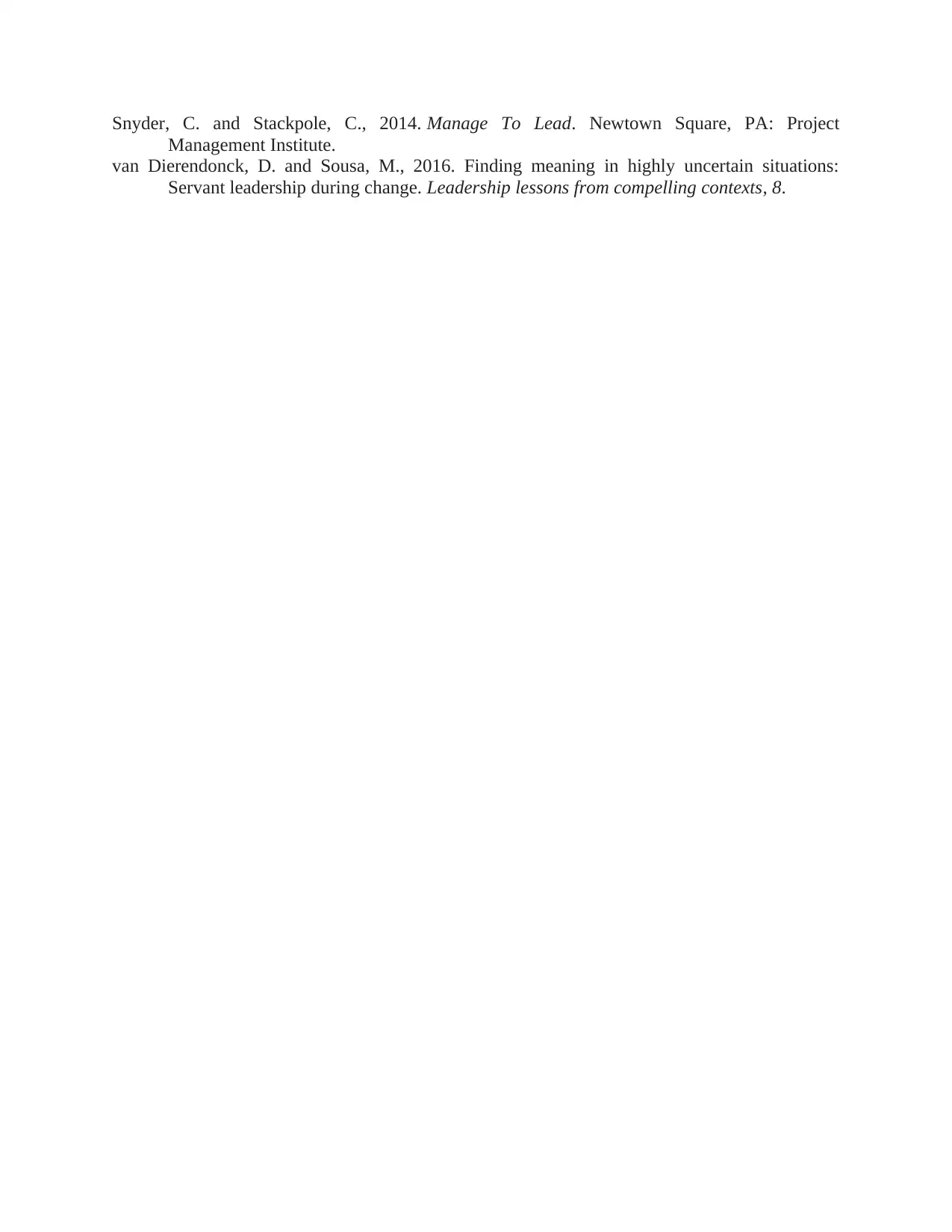
Snyder, C. and Stackpole, C., 2014. Manage To Lead. Newtown Square, PA: Project
Management Institute.
van Dierendonck, D. and Sousa, M., 2016. Finding meaning in highly uncertain situations:
Servant leadership during change. Leadership lessons from compelling contexts, 8.
Management Institute.
van Dierendonck, D. and Sousa, M., 2016. Finding meaning in highly uncertain situations:
Servant leadership during change. Leadership lessons from compelling contexts, 8.
1 out of 11
Related Documents
Your All-in-One AI-Powered Toolkit for Academic Success.
+13062052269
info@desklib.com
Available 24*7 on WhatsApp / Email
![[object Object]](/_next/static/media/star-bottom.7253800d.svg)
Unlock your academic potential
Copyright © 2020–2025 A2Z Services. All Rights Reserved. Developed and managed by ZUCOL.





